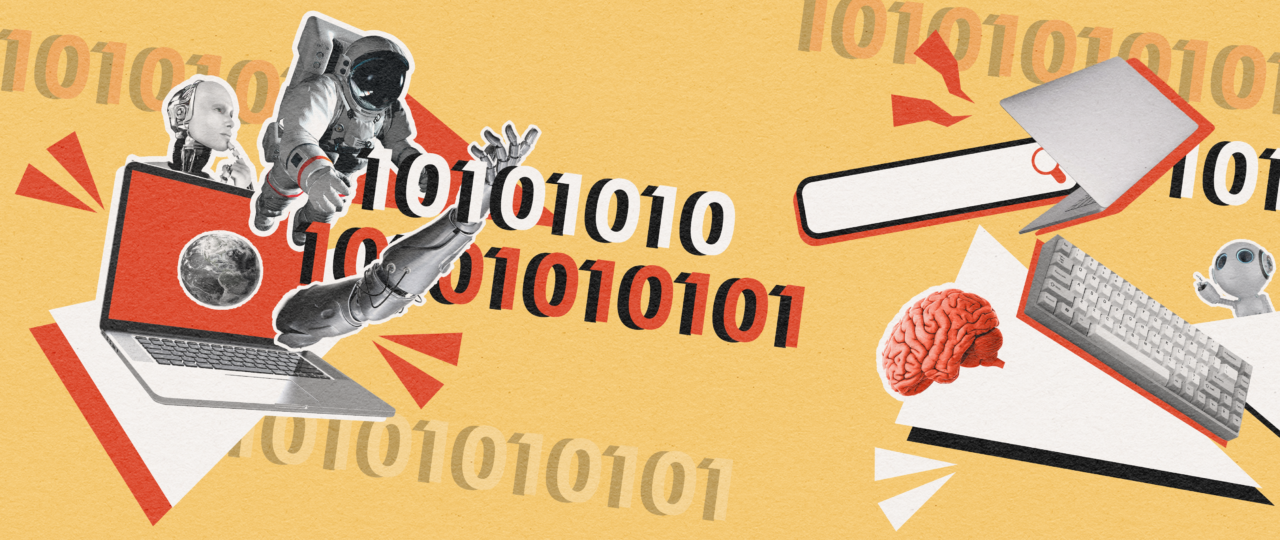In November 2022, the now-infamous chatbot, ChatGPT, sent shockwaves across the internet. You could ask it a question, just as you would a human, and it rattled off a human-like response. We even published a blog interviewing it ourselves.
This excited many people, but there was a wave of apprehensiveness that washed over others. Fear of job loss (especially for copywriters and coders), fear that students would get away with plagiarism more easily, and some people really feared that it was the start of some Terminator-esque doomsday.
So let me confidently settle those fears right now: AI is not “taking over,” and it’s been around way longer than you probably realize (what do you think powers the automated phone calls for big corporations?).
To begin gaining a better understanding of AI, let’s start with a definition. According to IBM, Artificial Intelligence is a set of technologies that leverage computers and machines to mimic the problem-solving and decision-making capabilities of the human mind.
In layman’s terms, AI = computers that are programmed to copy how we make choices by pulling information from databases. It’s important to understand that the knowledge that AI can gain is only as far as the data it can pull. It can not think freely or feel emotions, regardless of what the movies may tell you (i.e. I, Robot).

There are several types of AI, but the focus of today is chatbots since they’ve been garnering so much attention over the last six months. The three big players you should know about are ChatGPT, Jasper, and Bard. All three of these chatbots work in a similar way—they’re powered by what’s called a language learning model (LLM), which uses data to predict what the most appropriate word or set of words should come next in a given context. What makes these three products different are the type(s) of LLMs they use, and how much data they are able to accurately put out.
I did the research to give you the rundown, so that you don’t have to.
ChatGPT
This chatbot was created by AI research startup, Open AI, with a goal of making AI accessible. The company created a language learning model (LLM) called Generative Pre-trained Transformer, or GPT. Each version of GPT has a wider range of trainable parameters, or the capacity to optimize. Since its founding in 2015, Open AI has released 4 versions of GPT, each with expanded trainable parameters.
For some perspective, when ChatGPT was released in November of 2022, it ran on GPT 3.5 which had 355 billion trainable parameters. In March 2023, GPT 4 was released with 170 trillion trainable parameters. That’s TONS more space for computers to learn and optimize information.

To give you a real-life example, the Government of Iceland decided to implement GPT into their systems nationwide to help preserve the Icelandic language, which is being lost to English. They began to test this with GPT 3, but it was unable to “consistently produce clear and correct Icelandic translations.” When they tried again with GPT4, it was able to produce much better translations. It still isn’t perfect (grammatical errors are still common due to the complexity of Icelandic) but it has the capacity to learn and continue improving.
Open AI has partnered with several other popular brands to integrate their products including Duolingo, Khan Academy, and Snapchat among others. The next chatbot we’re going to cover was actually powered by GPT technology in its early stages!
Jasper
Jasper is a chatbot designed to specifically generate marketing copy, blog posts, social media captions, product descriptions, and much more within that wheelhouse. It was founded by Dave Rogenmoser, a former marketer who sought to create a tool to help advertisers write better. It’s essentially intended to solve writer’s block.
The product was underway when Open AI was looking for applications to run and test GPT 3, thus Jasper launched in 2021. Today, the product runs on a variety of LLMs including GPT 4, Bloom, and Jasper’s own technology, to name a few. Having so many LLMs powering it, it’s more likely to generate the strongest possible response based on the best combinations of models for a given prompt. It’s basically like having your own little writing genius on your shoulder.
Sounds too good to be true, right? The main pitfall with Jasper is that it’s expensive to run LLMs. With so many powering one product, it gets a little pricey. To give you an idea, pricing tiers start at $29 a month for up to 20,000 words. If you need more words than that, you’ll need to pay a higher subscription. Luckily, you can try it out for free before fully committing. Jasper offers a 5 day free trial for up to 10,000 words, so if you’re intrigued it’s definitely worth testing out.

Bard
The last chatbot we’re covering is Bard. You may have heard of this Google-owned product, which has a similar concept as ChatGPT. It’s been in the works since 2015 and was released in March 2023 as a beta. The goal of the beta is for the public to test the product and give feedback in hopes of improving it.
Currently, users can sign up for the waitlist to give it a try. Bard works on an LLM called LaMDA, which Google also developed, but there is limited information available as the full product still hasn’t officially launched. The goal of Bard (other than wanting to have a competitive product in the AI space) is to eventually integrate it into Google search tools to produce more precise and curated outputs.

But what about ____?
Now, at this point you may be wondering, with all the information that these chatbots have available, is there a risk of plagiarism? Could they give you false information? The good news is that ChatGPT and Jasper both have plagiarism detection technology. Unfortunately, Bard has yet to be integrated with such tech, but as it phases out of its beta stage, we can likely expect to see it there too. While the goal of these chatbots is to provide customized and accurate responses, they all warn that users should always use critical thinking and independent research as the use of these technologies continues to expand.
And I get it. You still probably have a lot of questions about AI, good or bad. Italy recently became the first Western country to ban ChatGPT, opening up a conversation on privacy and ownership laws. AI certainly has a long road ahead until its usage is perfect, both morally and functionally, but unlike other tech that booms to popularity and fades away (RIP NFTs), chatbots are likely going to be around for a while.
People have already begun reaping the benefits of them in all aspects of life—from helping write emails for work, to curating grocery lists and travel itineraries for personal use. So if you haven’t tried using ChatGPT, I highly recommend starting to play around with it to see what it can do for you (even if you’re only having it write funny stories about your friends). I put off trying it for months until I was tasked with doing research for an internal project and now I use it on an almost daily basis.
Corporate Considerations
If you also work at an ad agency, here are a few ways you can consider integrating AI chatbots into your own various teams (without scaring them into thinking AI will be replacing them at their jobs):
- Strategy teams: Meet your new best friends for idea generation. As a part of a strategy team myself, I can attest to this. If I ever find myself staring at a blank page for too long, I go straight to ChatGPT and ask for some ideas based on a very detailed brain dump. From there, I pick out the best ideas and pivot them for each of my clients’ unique needs.
- Creative teams: These tools were basically built for you! If you’re ever experiencing writer’s block, simply ask for some ideas on your topic of choice. You can even ask for an outline to break down an idea even further. Many social media managers have been using these tools to aid in social media copy. (Editor’s note: As the copywriter editing this, I can attest that ChatGPT has been helpful, essentially functioning as a glorified thesaurus as I’ve begun dipping my toe in the AI waters.)
- Account managers: I know you’re writing emails all day and I already mentioned how useful these tools have been for me when it comes to emails, so go ahead and try it out for yourself! (Tip: For finding the right tone, try asking it to rewrite an email in “a more professional” way. Just remember not to include any confidential info.) Additionally, if you struggle to write timelines, you can ask these tools for a detailed breakdown to give you a starting point.
- Ads teams: I’m not super tech savvy like you, so I may not have relatable experience. However, these tools are fantastic at analyzing data sets and can identify patterns for you and help you make decisions on optimizations. You can also use them to pull potential keywords for digital campaigns!
Over the years, we can expect to see more innovative uses for chatbots as they continue to integrate into apps that we use on a day-to-day basis. With their ability to streamline communication and automate routine tasks, it is evident that chatbots are here to stay.




